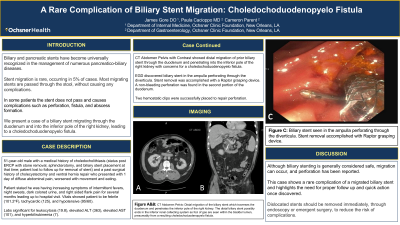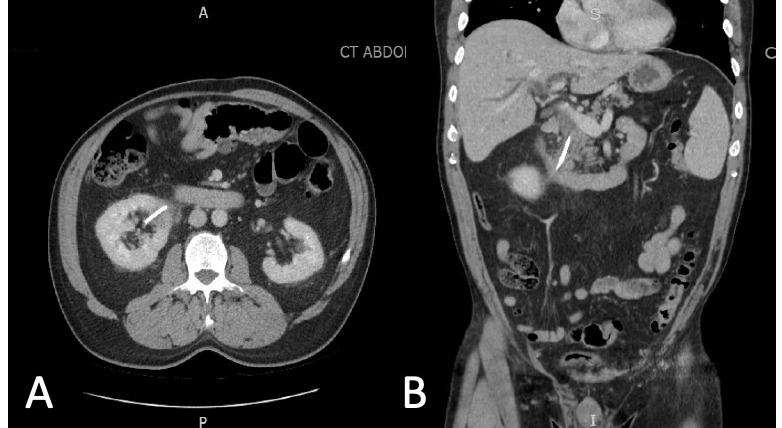Sunday Poster Session
Category: Interventional Endoscopy
P1085 - A Rare Complication of Biliary Stent Migration: Choledochoduodenopyelo Fistula
Sunday, October 27, 2024
3:30 PM - 7:00 PM ET
Location: Exhibit Hall E

Has Audio

James Gore, DO
Ochsner Health Clinic Foundation
New Orleans, LA
Presenting Author(s)
James Gore, DO, Paula Cacioppo, MD, Cameron Parent, MD
Ochsner Health Clinic Foundation, New Orleans, LA
Introduction: Biliary and pancreatic stents have become universally recognized in the management of numerous pancreatico-biliary diseases. Stent migration is rare, occurring in 5% of cases. Most migrating stents are passed through the stool, without causing any complications. In some patients the stent does not pass and causes complications such as perforation, fistula, and abscess formation. We present a case of a biliary stent migrating through the duodenum and into the inferior pole of the right kidney, leading to a choledochoduodenopyelo fistula.
Case Description/Methods: 51-year-old male with a medical history of choledocholithiasis (status post ERCP with stone removal, sphincterotomy, and biliary stent placement at that time; patient lost to follow up for removal of stent) and a past surgical history of cholecystectomy and ventral hernia repair who presented with 1 day of diffuse abdominal pain, worsened with movement and eating. Patient stated he was having increasing symptoms of intermittent fevers, night sweats, dark colored urine, and right sided flank pain for several months leading up to hospital visit. Vitals showed patient to be febrile (101.2oF), tachycardic (125), and hypotensive (95/60). Labs significant for leukocytosis (19.8), elevated ALT (363), elevated AST (101), and hyperbilirubinemia (7). CT Abdomen Pelvis with Contrast showed distal migration of prior biliary stent through the duodenum and penetrating into the inferior pole of the right kidney with concerns for a choledochoduodenopyelo fistula. EGD discovered biliary stent in the ampulla perforating through the diverticula. Stent removal was accomplished with a Raptor grasping device. A non-bleeding perforation was found in the second portion of the duodenum. Two hemostatic clips were successfully placed to repair perforation.
Discussion: Although biliary stenting is generally considered safe, migration can occur, and perforation has been reported. This case shows a rare complication of a migrated biliary stent and highlights the need for proper follow up and quick action once discovered. Dislocated stents should be removed immediately, through endoscopy or emergent surgery, to reduce the risk of complications.

Disclosures:
James Gore, DO, Paula Cacioppo, MD, Cameron Parent, MD. P1085 - A Rare Complication of Biliary Stent Migration: Choledochoduodenopyelo Fistula, ACG 2024 Annual Scientific Meeting Abstracts. Philadelphia, PA: American College of Gastroenterology.
Ochsner Health Clinic Foundation, New Orleans, LA
Introduction: Biliary and pancreatic stents have become universally recognized in the management of numerous pancreatico-biliary diseases. Stent migration is rare, occurring in 5% of cases. Most migrating stents are passed through the stool, without causing any complications. In some patients the stent does not pass and causes complications such as perforation, fistula, and abscess formation. We present a case of a biliary stent migrating through the duodenum and into the inferior pole of the right kidney, leading to a choledochoduodenopyelo fistula.
Case Description/Methods: 51-year-old male with a medical history of choledocholithiasis (status post ERCP with stone removal, sphincterotomy, and biliary stent placement at that time; patient lost to follow up for removal of stent) and a past surgical history of cholecystectomy and ventral hernia repair who presented with 1 day of diffuse abdominal pain, worsened with movement and eating. Patient stated he was having increasing symptoms of intermittent fevers, night sweats, dark colored urine, and right sided flank pain for several months leading up to hospital visit. Vitals showed patient to be febrile (101.2oF), tachycardic (125), and hypotensive (95/60). Labs significant for leukocytosis (19.8), elevated ALT (363), elevated AST (101), and hyperbilirubinemia (7). CT Abdomen Pelvis with Contrast showed distal migration of prior biliary stent through the duodenum and penetrating into the inferior pole of the right kidney with concerns for a choledochoduodenopyelo fistula. EGD discovered biliary stent in the ampulla perforating through the diverticula. Stent removal was accomplished with a Raptor grasping device. A non-bleeding perforation was found in the second portion of the duodenum. Two hemostatic clips were successfully placed to repair perforation.
Discussion: Although biliary stenting is generally considered safe, migration can occur, and perforation has been reported. This case shows a rare complication of a migrated biliary stent and highlights the need for proper follow up and quick action once discovered. Dislocated stents should be removed immediately, through endoscopy or emergent surgery, to reduce the risk of complications.

Figure: CT Abdomen Pelvis: Distal migration of the biliary stent which traverses the duodenum and penetrates the inferior pole of the right kidney. The distal biliary stent possibly ends in the inferior renal collecting system as foci of gas are seen within the bladder lumen, presumably from a resulting choledochoduodenopyelo fistula.
Disclosures:
James Gore indicated no relevant financial relationships.
Paula Cacioppo indicated no relevant financial relationships.
Cameron Parent indicated no relevant financial relationships.
James Gore, DO, Paula Cacioppo, MD, Cameron Parent, MD. P1085 - A Rare Complication of Biliary Stent Migration: Choledochoduodenopyelo Fistula, ACG 2024 Annual Scientific Meeting Abstracts. Philadelphia, PA: American College of Gastroenterology.
